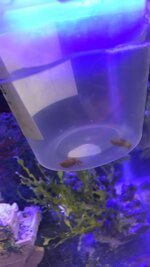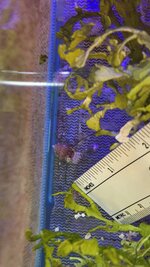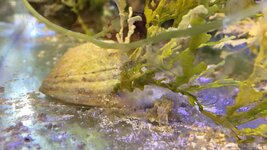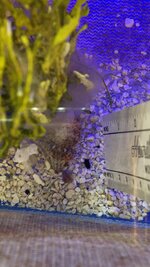Hi everyone!
This is my first post, but I've been keeping juvenile Sepia bandensis (dwarf cuttlefish) for nearly 6 months now. I've finally found time to post about what I've learned in keeping them, and hopefully it will help others who are looking at cuttlefish care!
I'm working on research with my cuttles, mainly focused on feeding behavior (I will make another post specifically about the research soon!). I'm working with a professor and housing them through Eastern Michigan University, and will be glad to answer any questions about them!
July 17, 2017 - Day 1!
My first two hatchlings arrived at my local fish store already hatched! I work at said fish store, and we generally get cuttlefish eggs/hatchlings about once a month or every two months in the wintertime.

These two cuties were housed in a small breeder net inside a ten gallon tank with only a small filter attached. I figured I'd upgrade as I got more cuttles and as they grew.
We fed them live mysids, and by July 29 they were each eating 2 shrimp a day. In terms of feeding and keeping the mysids alive: baby brine shrimp, phytoplankton, and liquid foods seemed to work great for them. However, as I was keeping them in a small jar with just an air stone, this called for lots of water changes. I've now put a fine-mesh sponge over the air stone, and this seems to work much better as I can easily just squeeze out the sponge.
August 1-2 - Alternative food
Introduced one new hatchling and one new egg to the original two cuttles, and they seemed to get along great. I also had run out of mysid shrimp, and started exploring alternatives.
Amphipods are listed in many places as the next-best food for juvenile cuttlefish, and I found this to be true for mine as well. Though amphipods are faster and sometimes larger than the mysid shrimp, the cuttlefish are quite interested in them and don't seem to notice a difference. In terms of raising amphipods, they are easily housed in a tank's sump or filter, and like to cling to fine-mesh filter media.
Brine shrimp have sometimes been listed as another alternative, but I've found cuttlefish don't like them nearly as much. They merely pick at brine, only eating them if they are very hungry. Brine shrimp are also not very nutritious, and should only be used if no other food is available.
Around this time is when my cuttlefish started exhibiting "walking" behavior, or pulling themselves across a substrate on their bottom two arms, generally while waving their top two in the air. This is similar to the flamboyant cuttlefish's best-known stance (
). I believe this is a sort of prey-luring tactic, with their waving arms as a lure, but sometimes the cuttles will raise their top two arms in a defensive display, such as when I get too close to them with my hand or a net.
This was also around the time they started to pay attention to people outside of the tank, watching me as I fed them!
August 7-15 - Death and new life
One older cuttlefish died, but this was the only death where I found very little remains, and I suspect it was cannibalized by one of its siblings. However, this has been the ONLY death I haven't found the entire remains, and I've been introducing new cuttlefish to one another the whole time I've been raising them. This makes me think that introducing two new cuttlefish to each other is generally fine as long as they are of similar size and age.
I also purchased a clutch of around 12 eggs, but only two hatched. The rest died and deflated, and had many small pods and flatworms feasting on the casings. Such is the nature of nature...
August 29 - Feeding frozen
At this point, I had 5 cuttles in my small breeder net at once, and for me this was a lot! I had started to try to feed them frozen mysids. I had scooped up the dead ones from my live population, and saved them. Four of the five cuttles accepted the food, but I could never get them to consistently take frozen shrimps as each shrimp had to be individually frozen (freezing many shrimps in the same container doesn't work!) and about the size of the live shrimp in order to be eaten. Also, in order to have a continuous supply of individually frozen shrimps, I needed to have a live batch; thus, I just kept buying live food (which gets very expensive!).
One cuttlefish had their first ink! I believe I scared it as I bent over the tank; however, the ink was very blob-like and mucus-y, so it was easily sucked up in a pipette. Whenever I see ink, I always try to get as much out of the tank as I can because not a lot is known about the ink contents (anyone know more than I do??).
September 11 - First large shrimp
Around this time, I purchased one new hatchling and three new eggs. I figured 5 cuttles was enough for one net, so I got another and put the newbies in.
One older cuttlefish died, so I thought maybe they weren't getting enough food. I gave each older cuttle a grass shrimp (saltwater version of a ghost shrimp), and after a few tries they figured it out! It seemed like the first one to catch the large shrimp helped the others to learn, as it only took the others one try to catch them.

In this photo, hopefully you can see how large the grass shrimp is compared with the cuttle that caught it!
Each cuttle that was given a large shrimp left behind the head. I think that the heads might be impalatable, or too hard; humans don't even eat shrimp heads, after all.
September 20 - Introducing TODD
We had a few of the older cuttlefish (around 2 months old) die of unknown cause. None of the tank parameters seemed to be off, but I didn't record any of them, so who knows.
Remember how I kept the breeder nets inside a ten gallon tank? Two of my cuttlefish had mysteriously disappeared...but I found them in the tank! The net had slipped from the side and down a little into the tank, as it was only attached with suction cups. Can you see the escaped cuttle in the picture??

I put both cuttles back in the breeder net, but one escaped again! I decided to see what it would do in its new space, and it grew. Fast. He grew to be over an inch long in less than two weeks! I dubbed him Tentacles Of Da Deep, or TODD for short (that's him in the above picture when he was small, and in the lower picture when larger!).

October 6 - Research and KH
We started to do feeding trial research on our youngest cuttles (non-invasive, non-harming; again, I will make an additional post soon!).
We also encountered some KH issues. For those who don't know, KH stands for carbonate hardness, or alkalinity, and can affect pH (the acidity of the water). Our KH was 2.7 (AHH! - this is a very, very low number; it's supposed to be around 7-8), and I started adding Reef Builder by Seachem to raise it. I added Reef Builder EVERY DAY for a WEEK until it got to 7-- and a week later, the KH was back to 4.8.
I don't know about you other ceph keepers, but do you have a problem with low alkalinity?? Is it something to do with the ink the cuttles secrete, or is it just my setup (for example, the KH was suspiciously raised when I added some sand to the tank)? Feel free to comment your thoughts!
Beyond
Since October, I have continued adding Reef Builder to raise my alkalinity (it keeps it at a stable 4.5). TODD, who was one of my first two cuttlefish ever, continues to grow and now stretches over 2 inches long (he's watching me as I type this from his favorite spot, inside a ceramic ship). Sepia's top size is around 3.5 inches, and they usually live between 6-8 months.
Most of the other hatchlings have died. I now only have three surviving out of over 30 eggs/hatchlings purchased, and TODD is the only one who's made it past four months (he's almost 6mo now). From the research I've done, it looks like about half of all cuttlefish eggs/hatchlings die before adulthood. Does this seem to be the case with you other ceph keepers? Let me know!
Thanks for reading to the end, and again, I'm happy to answer any questions you may have!
Happy Cuttleing!
This is my first post, but I've been keeping juvenile Sepia bandensis (dwarf cuttlefish) for nearly 6 months now. I've finally found time to post about what I've learned in keeping them, and hopefully it will help others who are looking at cuttlefish care!
I'm working on research with my cuttles, mainly focused on feeding behavior (I will make another post specifically about the research soon!). I'm working with a professor and housing them through Eastern Michigan University, and will be glad to answer any questions about them!
July 17, 2017 - Day 1!
My first two hatchlings arrived at my local fish store already hatched! I work at said fish store, and we generally get cuttlefish eggs/hatchlings about once a month or every two months in the wintertime.

These two cuties were housed in a small breeder net inside a ten gallon tank with only a small filter attached. I figured I'd upgrade as I got more cuttles and as they grew.
We fed them live mysids, and by July 29 they were each eating 2 shrimp a day. In terms of feeding and keeping the mysids alive: baby brine shrimp, phytoplankton, and liquid foods seemed to work great for them. However, as I was keeping them in a small jar with just an air stone, this called for lots of water changes. I've now put a fine-mesh sponge over the air stone, and this seems to work much better as I can easily just squeeze out the sponge.
August 1-2 - Alternative food
Introduced one new hatchling and one new egg to the original two cuttles, and they seemed to get along great. I also had run out of mysid shrimp, and started exploring alternatives.
Amphipods are listed in many places as the next-best food for juvenile cuttlefish, and I found this to be true for mine as well. Though amphipods are faster and sometimes larger than the mysid shrimp, the cuttlefish are quite interested in them and don't seem to notice a difference. In terms of raising amphipods, they are easily housed in a tank's sump or filter, and like to cling to fine-mesh filter media.
Brine shrimp have sometimes been listed as another alternative, but I've found cuttlefish don't like them nearly as much. They merely pick at brine, only eating them if they are very hungry. Brine shrimp are also not very nutritious, and should only be used if no other food is available.
Around this time is when my cuttlefish started exhibiting "walking" behavior, or pulling themselves across a substrate on their bottom two arms, generally while waving their top two in the air. This is similar to the flamboyant cuttlefish's best-known stance (
This was also around the time they started to pay attention to people outside of the tank, watching me as I fed them!
August 7-15 - Death and new life
One older cuttlefish died, but this was the only death where I found very little remains, and I suspect it was cannibalized by one of its siblings. However, this has been the ONLY death I haven't found the entire remains, and I've been introducing new cuttlefish to one another the whole time I've been raising them. This makes me think that introducing two new cuttlefish to each other is generally fine as long as they are of similar size and age.
I also purchased a clutch of around 12 eggs, but only two hatched. The rest died and deflated, and had many small pods and flatworms feasting on the casings. Such is the nature of nature...
August 29 - Feeding frozen
At this point, I had 5 cuttles in my small breeder net at once, and for me this was a lot! I had started to try to feed them frozen mysids. I had scooped up the dead ones from my live population, and saved them. Four of the five cuttles accepted the food, but I could never get them to consistently take frozen shrimps as each shrimp had to be individually frozen (freezing many shrimps in the same container doesn't work!) and about the size of the live shrimp in order to be eaten. Also, in order to have a continuous supply of individually frozen shrimps, I needed to have a live batch; thus, I just kept buying live food (which gets very expensive!).
One cuttlefish had their first ink! I believe I scared it as I bent over the tank; however, the ink was very blob-like and mucus-y, so it was easily sucked up in a pipette. Whenever I see ink, I always try to get as much out of the tank as I can because not a lot is known about the ink contents (anyone know more than I do??).
September 11 - First large shrimp
Around this time, I purchased one new hatchling and three new eggs. I figured 5 cuttles was enough for one net, so I got another and put the newbies in.
One older cuttlefish died, so I thought maybe they weren't getting enough food. I gave each older cuttle a grass shrimp (saltwater version of a ghost shrimp), and after a few tries they figured it out! It seemed like the first one to catch the large shrimp helped the others to learn, as it only took the others one try to catch them.

In this photo, hopefully you can see how large the grass shrimp is compared with the cuttle that caught it!
Each cuttle that was given a large shrimp left behind the head. I think that the heads might be impalatable, or too hard; humans don't even eat shrimp heads, after all.
September 20 - Introducing TODD
We had a few of the older cuttlefish (around 2 months old) die of unknown cause. None of the tank parameters seemed to be off, but I didn't record any of them, so who knows.
Remember how I kept the breeder nets inside a ten gallon tank? Two of my cuttlefish had mysteriously disappeared...but I found them in the tank! The net had slipped from the side and down a little into the tank, as it was only attached with suction cups. Can you see the escaped cuttle in the picture??

I put both cuttles back in the breeder net, but one escaped again! I decided to see what it would do in its new space, and it grew. Fast. He grew to be over an inch long in less than two weeks! I dubbed him Tentacles Of Da Deep, or TODD for short (that's him in the above picture when he was small, and in the lower picture when larger!).

October 6 - Research and KH
We started to do feeding trial research on our youngest cuttles (non-invasive, non-harming; again, I will make an additional post soon!).
We also encountered some KH issues. For those who don't know, KH stands for carbonate hardness, or alkalinity, and can affect pH (the acidity of the water). Our KH was 2.7 (AHH! - this is a very, very low number; it's supposed to be around 7-8), and I started adding Reef Builder by Seachem to raise it. I added Reef Builder EVERY DAY for a WEEK until it got to 7-- and a week later, the KH was back to 4.8.
I don't know about you other ceph keepers, but do you have a problem with low alkalinity?? Is it something to do with the ink the cuttles secrete, or is it just my setup (for example, the KH was suspiciously raised when I added some sand to the tank)? Feel free to comment your thoughts!
Beyond
Since October, I have continued adding Reef Builder to raise my alkalinity (it keeps it at a stable 4.5). TODD, who was one of my first two cuttlefish ever, continues to grow and now stretches over 2 inches long (he's watching me as I type this from his favorite spot, inside a ceramic ship). Sepia's top size is around 3.5 inches, and they usually live between 6-8 months.
Most of the other hatchlings have died. I now only have three surviving out of over 30 eggs/hatchlings purchased, and TODD is the only one who's made it past four months (he's almost 6mo now). From the research I've done, it looks like about half of all cuttlefish eggs/hatchlings die before adulthood. Does this seem to be the case with you other ceph keepers? Let me know!
Thanks for reading to the end, and again, I'm happy to answer any questions you may have!
Happy Cuttleing!

 BeakoftheDeep! Nice journal. Looking forward to reading about your feeding experiments.
BeakoftheDeep! Nice journal. Looking forward to reading about your feeding experiments.